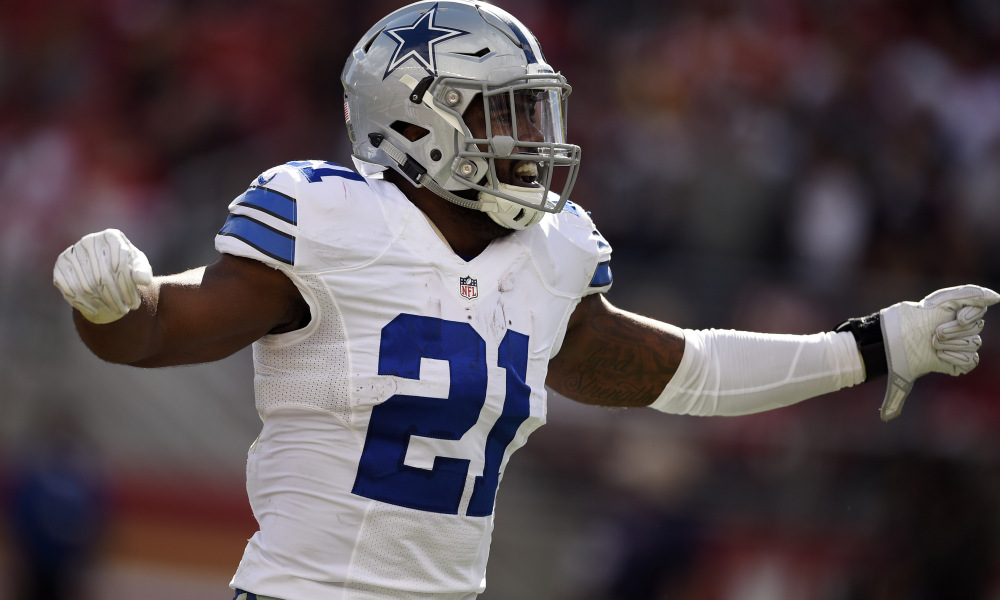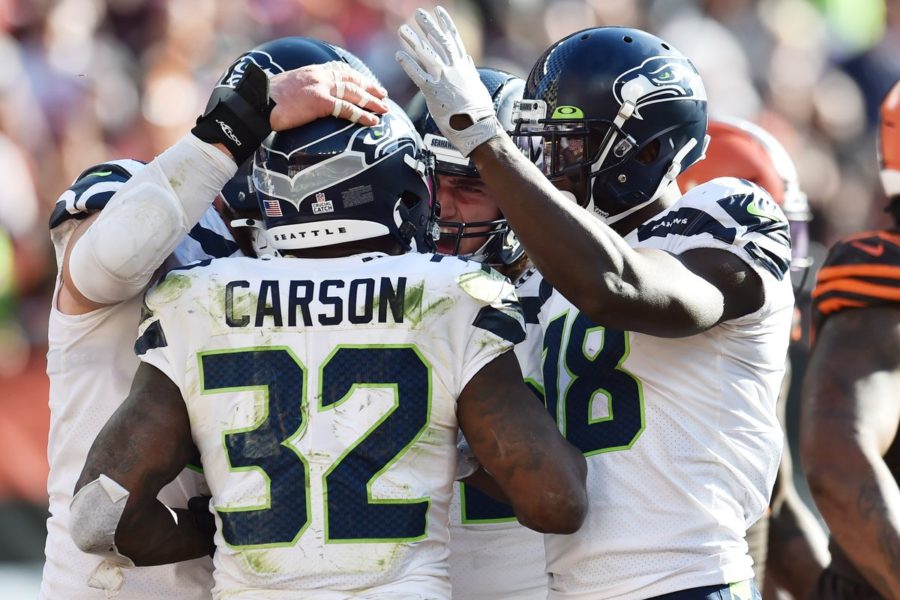NFL Game Scripts Week 3: Dallas Cowboys @ Seattle Seahawks
Although Dallas lost in Week 1 with a mediocre performance against the Rams, they managed a surprising comeback in Week 2 over the Falcons. Seattle meanwhile beat the Falcons in Week 1, improving throughout the second half, before edging out the Patriots in Week 2. Both teams look to be making statements as potential playoff teams, or even divisional winners, but a loss in this one will raise questions as we approach the quarter-mile post.
Dallas Cowboys Offense vs. Seattle Seahawks Defense
The Run Game

Despite having a trio of strong receivers, Dallas continue to be a run-first team. RB Ezekiel Elliott is best when running at the Tackles, and when he gets space to the outside is more effective. Dallas too often use Elliott heavily early, and while this at times can open up the passing game, it can also be a detriment as the Cowboys struggle to put up points early.
Instead, expect Dallas to be more balanced against Seattle and use Elliott just under 50% of the time on early drives as a rusher. He will still see use as a receiver, slipping underneath and providing a quick release for QB Dak Prescott. As the second half continues, Dallas will want a strong lead where they can lean on Elliott more, although are more likely to need to continue passing.
To free up Elliott, the Cowboys should look to have designed runs for Prescott, especially running outside of LT Tyron Smith (should he be cleared to play). Prescott will see a few snaps where he can take off, especially with a TE lined up on the right side to disguise the direction of a run. Potentially, fake hand offs and play action bootlegs will get Prescott moving more in the second half, and in turn also give Elliott more room to run as the Seahawks assign a defender to Prescott.
Seattle don’t necessarily need to spy Prescott with LB KJ Wright, but the latter will be instrumental in covering Elliott, and will instead be focused on him. To supplement this and make Dallas hesitant to run Prescott too much, Seattle will also line up Jamal Adams at the line of scrimmage to come off the edge. Between Wright, Adams and LB Bobby Wagner, Dallas will need to get creative and deceptive in their run game, and should do this early. Using WR Ceedee Lamb on screen passes will allow Dallas to force defenders out of the box and into coverage on the outside, giving Elliott a bit more space to run.
The Passing Game
Dallas regularly use 3 WR sets with levels passing concepts. Able to send all 3 starters – Amari Cooper, Michael Gallup and Lamb – on deep routes, as well as slants and intermediate in routes, makes it hard for opponents to assign their DBs. Although Cooper usually plays on the outside, being able to always have a different WR play deep, and the others on intermediate and short routes around the hash marks, means Cooper isn’t always faced with making tight sideline throws. While Elliott is used on swing routes and slants to the outside, the Cowboys are able to spread their receivers from sideline to sideline, as well as stretch the field to create space. Topping this off, they then use TEs on corner and post routes to get behind LBs and underneath CBs after the WRs clear space downfield.
In this game, the Cowboys should target TE Dalton Schultz during the first half, as the Seahawks don’t have anyone to match up against him without leaving them exposed deep. To support their run game, using Lamb on screens will also force Seattle to spread their defense, opening up the entire playbook. Dallas should also use slants regularly with Lamb and Gallup providing levels for Prescott to have easy reads. As the game goes on, using timing routes with Cooper on the outside using comebacks and corner routes will create additional space through the middle. As the game enters the second half, Elliott will see more work as a receiver, with Cooper and Schultz able to provide blocking downfield.
Seattle will be forced to play in nickel coverage a lot, and will need to keep a Safety deep constantly, if not two at times. KJ Wright provides exceptional cover skills, but should be deployed against Elliott mostly, and at times Schultz. Seattle will be forced to blitz often to try and disrupt Prescott’s rhythm and timing, but will avoid doing this in the first half as they gauge how their secondary is holding up.
What should we expect to see on Sunday?
Dallas will throw a little more than usual against Seattle, spreading the defense out. Getting short gains (if not long ones) early on with screens and TE passes will allow the full passing attack to be used as the game progresses. Prescott will run the ball at times, with Elliott increasingly used as a receiver, and getting more runs if Dallas have a lead. Seattle will rely on their playmakers in the middle of the field to be disruptive, but might find it not enough later in the game.
Seattle Seahawks Offense vs. Dallas Cowboys Defense
The Run Game

Seattle has, so far in 2020, been less run-orientated than would normally be expected. Part of this is due to the OL not being overly dominant. Another part is they’ve had close games and been forced to keep scoring, meaning they have continued to throw the ball. Another part is due to the heightened role of QB Russell Wilson. Unlike seasons past, there is less RB by committee, and Chris Carson is the main back occasionally spelled by Carlos Hyde. While short passes to the flats to RBs have been part of the extended run game of Seattle, Wilson has been what really makes their run game have success.
Although not running option plays, there are a few designed runs integrated into Seattle’s offense. These are mostly with Wilson moving outside of the tackle box before heading downfield, either off fake handoffs and bootlegs or with Wilson running a counter as the OL pushes one way, and he heads the opposite. Seattle will start to use these late in the first quarter, and if the first few have success continue into the second half, but if they expose Wilson to big hits too much, they will quickly be discontinued.
Carson, in addition to being used on screens and other passes on the outside, has had more success running outside of the tackles. Frequently using 21, 22 and 12 personnel sets, Carson gets space cleared for him by the TEs and occasionally a FB shifting sideways to create running lanes heading to the sideline. From these formations, Seattle will then use misdirection and counters with Carson as well as Wilson, running them to the strong side as the extra blockers draw the attention of extra LBs. Carson and Hyde will share carries in the first half, with Hyde going through the middle seeking to break through smaller gaps. Even if they have success though, unless they’re trying to control the clock and take the run away from Dallas, Seattle won’t overuse Carson in this one, as there will be little space to run on the edge.
Dallas has two strong edge defenders in Everson Griffen and Aldon Smith, who will force Carson to stay inside as much as possible, while also getting into the backfield regularly. While the Cowboys won’t spy Wilson with a singular LB, Aldon Smith and Jaylon Smith will be positioned over the tackles and verbally adjust coverage to track Carson and Wilson between them. Occasionally safety Xavier Woods will come up to the line of scrimmage to further restrict outside rushes, but Dallas will mostly rely on their front seven to get the job done, rotating in a nickel DB instead to try and cover the TEs in the passing game. Both Smiths can cover and defend the run well, but as the game progresses could be forced off the field a bit to get a more
The Passing Game
If their run game has taken a step back in 2020, Seattle’s passing game has been fully realised in the first two weeks. D.K. Metcalf has become a deep threat on the outside, constantly sent on vertical, corner and post routes to stretch the defense. Mostly using 2 WRs on the field, Tyler Lockett runs a wider variety of routes, although generally stays towards the outside with some slants and in routes 10-15 yards downfield. David Moore is the 3rd WR and will be moved from tight to the OL to the outside to spread opposing defenses further, giving either Lockett or Metcalf single coverage. Metcalf will go up against CB Chidobe Awuzie throughout the first half and will get past him a few times, allowing Wilson to take shots deep. This will then allow Lockett to use double moves on CB Trevon Diggs and cut inside to give Wilson a clear throwing lane. In the second quarter and onwards the Seahawks will use Moore to get either outside underneath the nickel CB or safety for chunk yardage.
Despite their use as blockers, Seattle’s TEs haven’t played a large role in the passing game yet. They are useful red-zone weapons, but mostly run out and slant routes to the outside, serving as the team’s short yardage receivers. Likewise Carson is the main receiving back, and generally is used with screens, and rarely gets split out as a receiver. Carson will see a few targets early to supplement the run, while the TEs will continue to see little use in the first half. Approaching half time, TE Greg Olsen will start to be sent on curls and hitch routes, so that the defense backs off and clears space for the RBs.
Dallas will be forced to substitute defenders regularly to defend both the run and pass. Safety Brandon Carr should see frequent time on the field to cover either the TEs, Moore, or Carson, especially in the second half if it remains close. The Cowboys could choose to use zone coverage more than usual in this one, so that as Lockett and Metcalf try to stretch the field, the underneath routes are also covered, forcing Wilson into more difficult throws. Although Wilson has good deep ball accuracy, the completion rate is much lower than shorter throws. With a strong pass rush, Dallas will hope that if they flush Wilson out of the pocket, they can bring him down before he escapes and finds space. Early pressure will restrict the Seahawks’ run game, and consequently allow more focus to be on defending the pass.
What should we expect to see on Sunday?
Seattle will look for deep completions early, and Dallas should be tempted to let them try if it means they are taking away shorter, safer options. The Seahawks will expand their passing game into the second and third quarter, but their deep passing attack means they are constantly in the contest, even if they fall more than one score behind, and can continue using this all game if they need to. The Cowboys will be wary of blitzing Wilson to avoid leaving space for him to run into if he escapes. However, with some early success in pressuring him, they could feel more confident in doing so later. Dallas will rotate defenders in as well to try and find the right coverage without compromising their run defense, and by the third quarter should settle on a happy medium.

